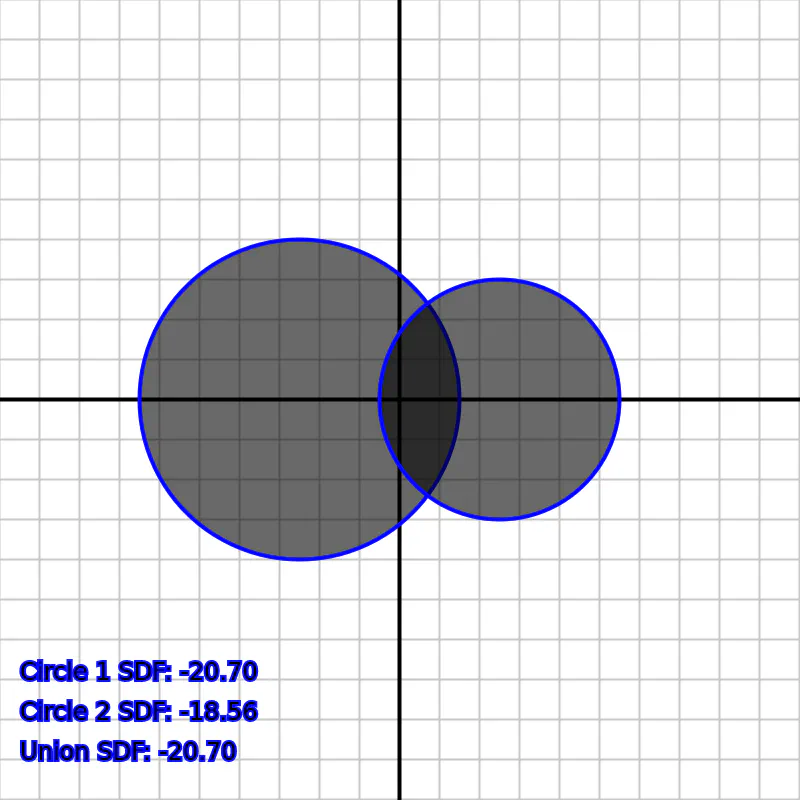Exploring Boolean Operations in SDFs: Union, Difference, and Intersection
Merging, Carving, and Intersecting Shapes with SDFs
 Boolean Operations on SDFs (Union, Difference, Intersection)
Boolean Operations on SDFs (Union, Difference, Intersection)In our previous explorations of Signed Distance Functions (SDFs), we unveiled their power in representing and manipulating geometric shapes. We also delved into the intricacies of SDFs for lines and rectangles. Now, let’s unlock the potential of Boolean operations on SDFs, enabling the creation of even more complex shapes.
Merging Shapes with Union: A Powerful Tool
The Union operation in SDFs allows us to combine two or more shapes, essentially merging them into a single new shape. Mathematically, the union of two SDFs,
This operation essentially takes the minimum distance value from either SDF at each point (P). Points outside of both shape A or B will have a positive SDF value, indicating they lie outside the combined shape. Points within both shapes A and B will have a negative value, signifying their position inside the resulting union shape.
Union of Two Circles
The visualization of the union of two circles SDF is also available at
union_sdf.pyusing py5 module.
Carving Shapes with Difference: Subtracting One from Another
The Difference operation in Signed Distance Functions (SDFs) enables us to sculpt one shape by subtracting another. Mathematically, the difference of
Here, the negative of
Difference of Two Circles (Circle 1 - Circle 2)
The visualization of the difference of two circles SDF is also available at
diff_sdf.pyusing py5 module.
Finding the Common Ground: Intersection of Shapes
The Intersection operation in SDFs allows us to identify the region where two shapes overlap. Mathematically, the intersection of
In this case, the maximum distance value is taken. Points outside both shapes A and B will have positive SDF values. Points inside either shape A or B (but not their overlap) will also have positive values. Points that lie within the overlapping region of both shapes A and B will have a negative SDF value, signifying their location within the intersection.
Intersection of Two Circles
The visualization of the intersection of two circles SDF is also available at
intersect_sdf.pyusing py5 module.
A Composition of Lines: The SDF of a Rectangle
While we’ve explored circles and other shapes, it’s important to remember that even seemingly basic shapes can be constructed using SDFs and Boolean operations. Take a rectangle, for instance. We can define a rectangle as the intersection of four lines, each representing the distance to an edge:
- The distance to the top edge of the rectangle.
- The distance to the bottom edge.
- The distance to the left edge.
- The distance to the right edge.
Rectangle SDF
The visualization of the rectangle defined by intersection of 4 lines is also available at
rect_by_intersect_sdf.pyusing py5 module.
The order of these intersections does not matter. Taking the maximum distance (intersection) from all four lines simultaneously would define a rectangle. Alternatively, we can perform the intersection progressively.
This concept extends beyond rectangles. Any polygon can be defined similarly using the intersection of line SDFs representing distances to its edges.
Defining Complex Domains with SDF Boolean Operations
By mastering Boolean operations on SDFs, we unlock the ability to create mathematically defined representations of even intricate 2D domains. From simple geometric shapes to elaborate, user-defined patterns, these techniques empower us to model a vast array of scenarios. This opens doors for various applications, from scientific simulations to artistic expression, all leveraging the power of mathematics and code to define complex shapes and spaces.